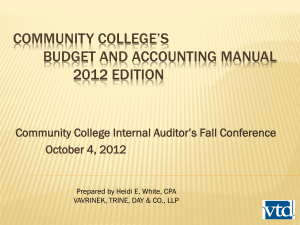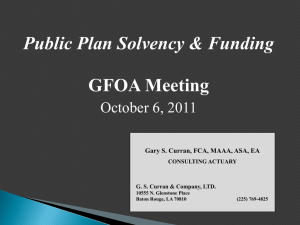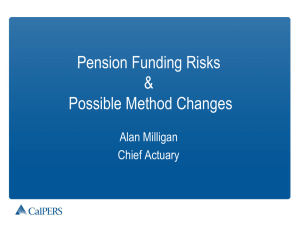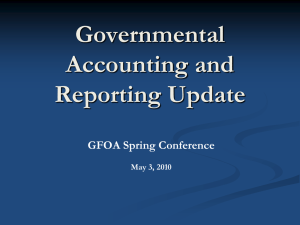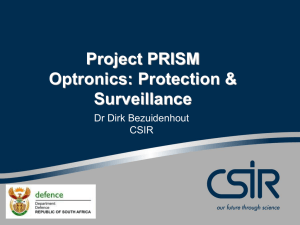GASB Statement No. 72 – Fair Value Measurement and
advertisement
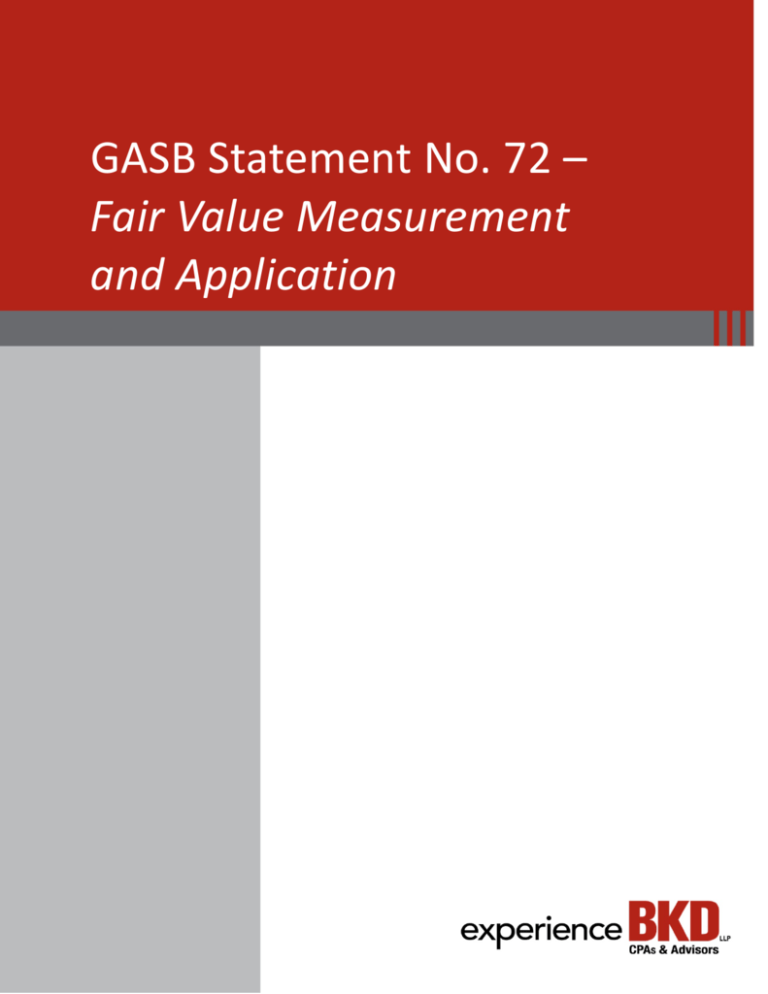
GASB Statement No. 72 – Fair Value Measurement and Application GASB Statement No. 72 – Fair Value Measurement and Application Table of Contents INTRODUCTION ..................................................................................................................................................... 3 SCOPE .................................................................................................................................................................... 3 INVESTMENTS ................................................................................................................................................................3 Common Stock ......................................................................................................................................................4 INVESTMENTS EXEMPT FROM FAIR VALUE MEASUREMENT.....................................................................................................4 Acquisition Value ..................................................................................................................................................5 FAIR VALUE DEFINITION ........................................................................................................................................ 5 EXIT PRICE ....................................................................................................................................................................6 Transaction Costs ..................................................................................................................................................6 Liabilities ...............................................................................................................................................................6 MEASUREMENT DATE .....................................................................................................................................................6 MARKET .......................................................................................................................................................................6 ORDERLY TRANSACTIONS .................................................................................................................................................7 UNIT OF ACCOUNT ................................................................................................................................................. 7 FAIR VALUE HIERARCHY ......................................................................................................................................... 7 LEVEL 1 INPUTS .............................................................................................................................................................7 LEVEL 2 INPUTS .............................................................................................................................................................8 LEVEL 3 INPUTS .............................................................................................................................................................8 NET ASSET VALUE (NAV) ........................................................................................................................................ 8 VALUATION TECHNIQUES & APPROACHES ............................................................................................................ 9 MARKET APPROACH .......................................................................................................................................................9 COST APPROACH ............................................................................................................................................................9 INCOME APPROACH ........................................................................................................................................................9 DISCLOSURES ......................................................................................................................................................... 9 EFFECTIVE DATE & TRANSITION ........................................................................................................................... 12 CONTRIBUTOR ..................................................................................................................................................... 12 2 GASB Statement No. 72 – Fair Value Measurement and Application Introduction On March 2, 2015, the Governmental Accounting Standards Board (GASB) released Statement No. 72, Fair Value Measurement and Application, which would generally require state and local governments to measure investments at fair value. GASB’s goal is to enhance comparability of governmental financial statements by requiring fair value measurement for certain assets and liabilities using a consistent definition and accepted valuation techniques. This standard expands fair value disclosures to provide comprehensive information for financial statement users about the impact of fair value measurements on a government’s financial position. The requirements are effective for financial statements for periods beginning after June 15, 2015, with early application encouraged. Governments should consider what additional investments may be subject to fair value measurement and if existing internal controls are sufficient. Governments also should consider if current information systems are adequate to provide the information required for the new disclosures and if any valuation specialists may be needed. Scope The standard requires fair value measurement for certain investments not previously measured at fair value, but it does not expand scope to other assets or liabilities not previously measured at fair value. The provisions of this statement should be applied to financial statements of all state and local governments. Investments Investments generally would be measured at fair value. GASB defines an investment asset as “a security or other asset that a government holds primarily for the purpose of income or profit and its present service capacity is based solely on its ability to generate cash or to be sold to generate cash.” The investment designation would be made at acquisition and would remain for the life of the asset, even if usage changes over time. An asset initially reported as a capital asset and later held for sale would not subsequently be reclassified as an investment. The following investments require value measurement: Alternative investments reported by endowments Equity securities (including unit investment trusts and closed-end mutual funds), stock warrants and stock rights that do not have readily determinable fair values Intangible assets meeting the proposed definition of investments Land and land rights, including oil and gas properties, classified as investments Commingled investment pools that are not government sponsored Invested securities lending collateral Real estate meeting the definition of an investment asset Life settlement contracts (when there is no insurable interest, the purpose of the instrument is solely to generate cash and should be measured at fair value) Debt securities reported as assets (regardless of whether they meet the definition of an investment or they were acquired or originated by the government) Securitized debt obligations 3 GASB Statement No. 72 – Fair Value Measurement and Application Unlike the Financial Accounting Standards Board (FASB), GASB has rejected adopting a held-to-maturity category, primarily due to the difficulty of determining when a decline is other than temporary and the challenges for auditors in assessing whether management has the ability and the intent to hold to maturity. GASB has continued some cost-based measurements in the exceptions to fair value, noted below. GASB believes that by not allowing a held-to-maturity classification, transparency and comparability is enhanced in the reporting of investments. Governments with investments that have significant fair value changes should report those changes as gains and losses based on whether those gains and losses represent change in the government’s ability to finance its activities and in the financial resources available to finance claims on the government’s resources. Common Stock The standard eliminates the cost method for investments in common stock. Common stock investments would be measured at fair value unless the criteria are met for the equity method, noted in the table below. GASB has expanded the exclusions from the equity method, in order to limit the exceptions to fair value measurement. Equity method holdings not meeting the definition of investment would continue to be reported using the cost method. Example If common stock is held as a result of economic development activities, such as providing venture capital, the equity interest does not meet the definition of an investment because the asset is held primarily for economic development and not “primarily for the purpose of income or profit.” Equity Method (Statement 62) Significant interest with less than 50% ownership. Indicators: Representation on the governing body Participation in policy making process Significant intra-entity transactions Interchange of management personnel Technological dependency Exclusions from Equity Method Common stock held by the following: External investment pools Pension or other postemployment benefit plans Deferred compensation plans (IRS Section 457) Endowments, including permanent and term endowments, and permanent funds** Investments using Net Asset Value (NAV) ** Investments in joint ventures or component units ** Additions to current guidance Investments Exempt from Fair Value Measurement The following investments would be measured in accordance with existing literature and not at fair value: Investments in nonparticipating interest-earning investment contracts (cost-based measure) Investments in unallocated insurance contracts (should be reported as interest-earning investment contracts according to the provisions of Statement No. 31 or Statement No. 59) 4 GASB Statement No. 72 – Fair Value Measurement and Application Money market investments and participating interest-earning investment contracts that have remaining maturity at time of purchase of one year or less and are held by governments other than external investment pools (amortized cost) Investments held by 2a-7 external investment pools (amortized cost) Investments in 2a7-like pools (NAV per share) Synthetic guaranteed investment contracts that are fully benefit-responsive (contract value) Investments in life insurance contracts that do not meet the definition of a life settlement contract (cash surrender value) The existing specialized guidance for mortgage loans held by public entity risk pools and other insurance organizations would be eliminated. However, mortgage loans or student loans that are a direct government service (and not solely to generate cash) would not meet the definition of an investment and should be classified as loans receivable. Acquisition Value Acquisition value is the price that would be paid to acquire an asset with equivalent service potential or the amount for which a liability could be liquidated at the acquisition date. GASB believes, for the following assets, an entry-price measurement is more appropriate than an exit-price measurement because the transaction represents the government acquiring the asset: Other Measurement Changes Asset GASB - Current GASB - New Model Donated capital assets Estimated fair value at acquisition plus ancillary charges, if any Acquisition value Donated works of art or historical treasures Historical cost or fair value at date of donation Acquisition value Capital assets received in a service concession arrangement Fair value Acquisition value Fair Value Definition GASB’s revised definition of fair value is more closely aligned with FASB’s definition, as noted below: Fair Value Definition FASB 157 GASB - Current GASB - New Model Fair value is the price that would be received to sell an asset or paid to transfer a liability in an orderly transaction between market participants at the measurement date The amount at which an investment could be exchanged in a current transaction between willing parties, other than in a forced or liquidation sale Fair value is the price that would be received to sell an asset or paid to transfer a liability in an orderly transaction between market participants at the measurement date 5 GASB Statement No. 72 – Fair Value Measurement and Application Exit Price The fair value definition focuses on the price that would be received to sell an asset or paid to transfer a liability— an exit price. Entities do not necessarily sell assets at the price paid to acquire them—an entry price. In some cases, the entry price may equal the exit price and therefore represent fair value. Fair value would be considered from the perspective of market participants and would not be an entity-specific measurement, as evidenced by the subtle change in GASB’s definition from “willing parties” to “market participants.” For nonfinancial assets, the price should represent the value of the asset at its highest and best use as determined by market participants, taking into account uses that are physically possible, legally permissible and financially feasible. The standard presumes the government’s use of nonfinancial property, as currently zoned, is its highest and best use. Transaction Costs Transaction costs, which exclude transportation costs, represent the incremental direct costs incurred to sell an asset or transfer a liability, e.g., brokerage commissions. These costs can vary from government to government and are entity-specific rather than market-based. Governments should consider transaction costs to determine the most advantageous market in order to increase profit or reduce losses. However, because transaction costs are not attributes of an asset or liability, the price used to measure fair value would not be adjusted for transaction costs. The standard supersedes existing guidance on transaction costs in defined pension and other postemployment benefit (OPEB) plans. Liabilities Measurement of a liability’s fair value assumes the liability would remain outstanding and not be cash settled or otherwise extinguished; the transferee would be required to fulfill the obligation. Such markets might be limited, and GASB permits using an observable market price if the liability is held as an asset by another market participant. Parties holding the obligations as assets would consider the entity’s credit rating in determining the price they would be willing to pay; therefore, GASB would require the price to be adjusted for credit quality. Governments are restricted from using a portfolio approach, i.e., netting any offsetting long or short positions. FASB recently released an accounting standard update allowing nonpublic entities to use settlement value as a practical expedient to determining fair value for certain interest rate swaps. GASB concluded settlement value is not an appropriate alternative to reporting the fair value of an asset or liability. Measurement Date GASB has modified the definition of fair value proposed substituting “measurement date” for “current transaction.” This edit emphasizes that the measurement date can be based on either an event or transaction or the financial statement reporting date. GASB cites the example of an impaired capital asset held for sale, where the measurement date of fair value may be different than the date of the financial report. Market The market to which the definition of fair value refers is the government’s principal market or, when there is not a principal market, the entity’s most advantageous market, after taking into account transaction and transportation costs. The most advantageous market is the one in which a government could sell an asset for the maximum amount or transfer a liability for the minimum amount. 6 GASB Statement No. 72 – Fair Value Measurement and Application Orderly Transactions To determine whether a transaction is orderly, a government should consider readily available information. Even if there has been a significant decrease in activity volume, it would not be appropriate to conclude all transactions in that market are not orderly. GASB provides some indicators that a transaction is not orderly: Usual and customary marketing activities were inadequate for the transaction The seller marketed the asset or liability to a single market participant The seller is in or near bankruptcy The seller is required to sell to meet regulatory or legal requirements The transaction price is an outlier when compared to other recent transactions for similar assets or liabilities Unit of Account This standard introduces into GASB authoritative literature the term “unit of account,” referring to the level at which an asset or a liability is aggregated or disaggregated for measurement. The amounts reported would vary depending on the relevant measurement attribute applied—historical cost, fair value, replacement cost or settlement amount. The unit of account may be a single asset or liability, e.g., a financial instrument, a group of assets, a group of liabilities or a group of related assets and liabilities, e.g., a partnership. Fair Value Hierarchy Valuation inputs are assumptions that market participants use in pricing an asset or liability. The standard establishes a hierarchy of inputs used to measure fair value that prioritizes the inputs into three categories— Level 1, Level 2 and Level 3 inputs—considering the relative reliability of the inputs. GASB chose to leverage the input hierarchy in FASB Statement 157, Fair Value Measurement. The level is determined based on the lowest level of input significant to the measurement in its entirety. Premiums or discounts based on the government’s transaction size, i.e., “blockage factors,” should not be a valuation input or a price adjustment for any level of the hierarchy. Introduction of a third category is a change from current requirements that allow for only two possibilities— prices that are market-observed and those that are not. Level 1 Inputs Level 1 inputs are quoted (unadjusted) prices in active markets for identical assets or liabilities that the government can access at the measurement date. Observable markets include exchange markets, dealer markets, brokered markets and principal-to-principal markets. 7 GASB Statement No. 72 – Fair Value Measurement and Application Level 2 Inputs These are inputs other than quoted prices included within Level 1 that are observable for the asset or liability, either directly or indirectly. These inputs are derived from or corroborated by observable market data through correlation or by other means, e.g., “market-corroborated” inputs. Level 2 inputs include: Quoted prices for similar assets or liabilities in active markets Quoted prices for identical or similar assets or liabilities in inactive markets Inputs other than quoted prices that are observable for the asset or liability, such as: • • • Interest rates and yield curves observable at commonly quoted intervals Implied volatilities Credit spreads Market-corroborated inputs Level 2 Input Examples For a bond valued by a pricing service using matrix pricing – price or yield of a similar bond For a three-year option on exchange-traded shares – a Level 2 input would be the extrapolated implied volatility for the shares For a valuation multiple – a multiple of earnings or revenue from observable market data involving similar businesses, taking into account operational, market, financial and nonfinancial factors Level 3 Inputs These are unobservable inputs for the asset or liability; they should be used only when relevant Level 1 and Level 2 inputs are unavailable. Governments may use their own data to develop unobservable inputs if there is no information available without undue cost and effort. Level 3 Input Examples For a three-year option on exchange-traded shares – the volatility for the shares derived from historical prices would be Level 3 input since the data does not represent current market participants’ expectations about future volatility For an interest rate swap – nonbinding quote that cannot otherwise be corroborated by observable market data For commercial real estate – a financial forecast developed using the government’s own data GASB chose to leverage the input hierarchy in FASB Statement 157, Fair Value Measurement, which is used by most custody banks and pricing services. Net Asset Value (NAV) As a practical expedient, a government can use the NAV per share for investments in a nongovernmental entity that does not have a readily determinable fair value, e.g., a hedge fund. The NAV is not permitted for valuation if it is probable the government will sell the investment at a different price. Investments measured at NAV would be excluded from the fair value hierarchy (Level 1, 2 or 3). 8 GASB Statement No. 72 – Fair Value Measurement and Application Valuation Techniques & Approaches There can be many ways to determine the fair value of an asset or liability, and the standard allows for many possible valuation techniques using one or more of three approaches: market, cost or income approach. The fair value hierarchy does not prioritize valuation techniques; governments should use the appropriate technique, increasing use of reliable observable inputs and reducing the use of unobservable inputs. Governments will need to calibrate valuation models using unobservable inputs to ensure output values correlate with observable market data at measurement date. Valuation techniques should be consistently applied from period to period. However, a change is appropriate if it results in a measurement more representative of fair value, e.g.: New markets develop New information becomes available Previously used information is no longer available Valuation techniques improve Market conditions change Changes in valuation techniques or application to other assets and liabilities should be accounted for as a change in accounting estimate. Governments relying on a pricing service or custody bank for fair values will need to closely review statements to ensure valuation changes are correctly reported. Market Approach The market approach uses prices and other relevant information generated by market transactions involving identical or similar assets, liabilities or a group of assets and liabilities, e.g., quoted market prices. Matrix pricing, which relies on the securities’ relationship to other benchmark quoted securities, is another technique consistent with the market approach. Quoted prices provided by third parties may be used if developed following the provisions of this standard. Binding quotes should be used before indicative prices, if available. Cost Approach The cost approach reflects the amount currently required to replace the present service capacity of an asset, adjusted for obsolescence. Income Approach The income approach converts future amounts, e.g., cash flows or revenues and expenses, to a single current amount such as discounted present value, reflecting current market expectations about those future amounts. Valuation techniques consistent with the income approach include present value, option pricing models such as the Black-Scholes-Merton formula and the multiperiod excess earnings method. Disclosures Current GASB standards require disclosure for some, but not all, fair value measurements, as noted in the table below. This standard expands scope to require disclosure for all fair value measurements. GASB did not prescribe a set format for the disclosures; governments may present the information in either narrative or tabular format. 9 GASB Statement No. 72 – Fair Value Measurement and Application Current Fair Value Measurement Disclosures Standard Disclosure Statement 31, Accounting and Financial Reporting for Certain Investments and for External Investment Pools Methods and significant assumptions used to estimate the fair value of investments, if fair value is based on other than quoted market prices Statement 3, Deposits with Financial Institutions, Investments (including Repurchase Agreements), and Reverse Repurchase Agreements Statement 40, Deposit and Investment Risk Disclosures—an amendment of GASB Statement No. 3 Disclosure of credit risk, custodial credit risk and interest rate risk Statement 53, Accounting and Financial Reporting for Derivative Instruments The new disclosures would be organized by type of asset or liability, which differs from current guidance that focuses on reporting entity segments, such as governmental activities, major fund types and component units. The standard provides general guidelines rather than prescriptive requirements regarding the appropriate level of detail and will require professional judgment. Level of Disaggregation Current GASB No. 40 The disclosures generally should be made for the primary government, including its blended component units. Risk disclosures also should be made for governmental and business-type activities, individual major funds, nonmajor funds in the aggregate or fiduciary fund types when the risk exposures are significantly greater than the deposit and investment risks of the primary government Statement No. 72 The level of detail and disaggregation, and how much emphasis to place on each disclosure requirement, should take into account the following considerations: Nature, characteristics and risks of the asset or liability Level of the fair value hierarchy within which the fair value measurement is categorized Whether this statement or another statement specifies a type for an asset or a liability Objective or the mission of the government Characteristics of the government Relative significance of assets and liabilities Whether separately issued financial statements are available Line items presented in the statement of net position 10 GASB Statement No. 72 – Fair Value Measurement and Application The following disclosures are required for recurring and nonrecurring fair value measurements: Fair value measurement at the end of the reporting period Level of fair value hierarchy (excluding any investments measured at NAV) A description of the valuation techniques used For significant changes in valuation techniques, the changes and the reason for making them Disclosure is required for the reason for any nonrecurring measurements. GASB felt investments measured using NAV have increased uncertainty and subjectivity, requiring additional disclosure for financial statement users to understand the investment’s nature and risks and whether such investments are likely to be sold at an amount different from NAV per share. Disclosures include: Fair value measurement of the investment type and a description of the significant investment strategies For investments that can never be redeemed with the investees, the government’s estimate of the liquidation period Amount of unfunded commitments General description of the redemption terms and conditions Redemption restrictions, an estimate of length of restriction period or how long restriction has been in place Any other significant selling restrictions Fair value of investments for any planned sales at an amount different from NAV per share and any remaining actions required to complete the sale If a sale is planned but not all assets have been identified, the government’s plans to sell and any remaining actions required to complete the sale Investments Measured at the NAV ($ in millions) Investment Strategy Equity long/short hedge funds Fair Value 1 Unfunded Commitments $55 Redemption Frequency (if currently eligible) Redemption Notice Period Quarterly 30 - 60 days Event-driven hedge funds 45 Quarterly, annually 30 - 60 days Global opportunity hedge funds 35 Quarterly 30 - 45 days Multi-strategy hedge funds 40 Quarterly 30 - 60 days Real estate funds 47 Total Investments measured at NAV Private equity funds - international (1) $20 $222 $43 $15 This type includes investments in 12 hedge funds that invest both long and short primarily in U.S. common stocks; 22 percent of these investments cannot be redeemed due to a restriction for a holding period of 12 to 18 months. The remaining restriction period for these investments ranged from three to seven months at December 31. The standard does not prescribe either a tabular or a narrative format, in an effort to allow governments flexibility in presenting the required information. 11 GASB Statement No. 72 – Fair Value Measurement and Application Effective Date & Transition The requirements are effective for financial statements for reporting periods beginning after June 15, 2015. Early application is encouraged. In the period first applied, changes made to comply with this standard should be treated as an adjustment of prior periods, and financial statements presented for the periods affected should be restated. If restatement for all prior periods presented is not practical, the cumulative effect should be reported as a restatement of beginning net position for the earliest period restated, with an explanation of the reason for not restating. The use of acquisition value should be applied prospectively to new transactions. To learn more about how this change could affect your organization, contact your BKD advisor. Contributor Anne Coughlan Director 317.383.4000 acoughlan@bkd.com 12
